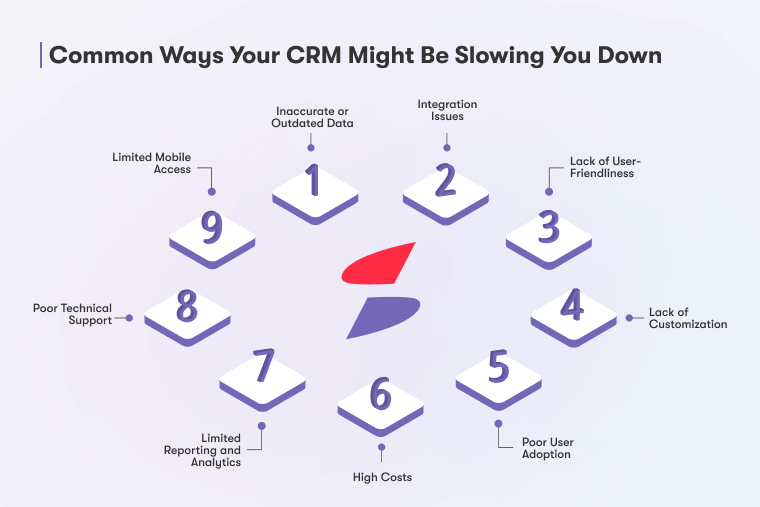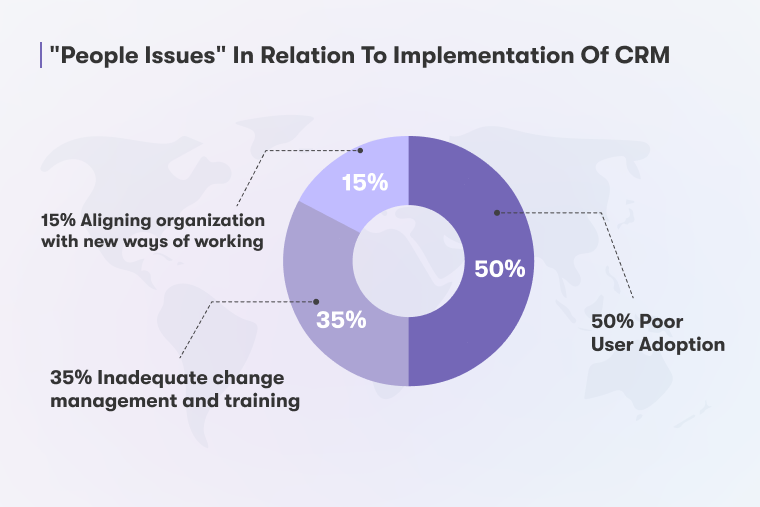Quick Summary
Poorly planned and implemented customer relationship management systems will aid your company in managing customer interactions more effectively. Herein, we will discuss the top customer relationship management issues keeping you back, with actionable solutions and real examples to help you squeeze out the best value of the CRM system.
Introduction
In the present day, when competition is the order of the day, maintaining customer relations and driving sales to the optimum requires the use of an efficient CRM system. Unfortunately, for most businesses, rather the revolution has brought about CRM-related challenges such as poor user adoption, wrong data, and absence of customization, among others. These issues could also be the unproclaimed fatal aggressors for your sales performance.
In this blog, we will discuss the most common 13 CRM issues, and their solutions, enlist statistics, present examples, and help you avoid these pitfalls.
Common Ways Your CRM Might Be Slowing You Down

Inaccurate or Outdated Data
Picture this: Mike, the marketing manager at an online retail store, prepared a campaign for loyal customers. However, when emails went out, many bounced back, and the rest reached customers who had already unsubscribed. Why? His CRM was full of outdated data. Marketing efforts were wasted, and Mike’s team scrambled to fix the mess.
Solution:
To avoid this, Mike’s company implemented real-time data syncing and set up automated data validation. Regular data audits ensured that information remained accurate, and up-to-date, enabling them to refine their targeting and recover lost opportunities.
- Stats:
Inaccurate data is responsible for a 15% to 25% loss in overall business revenue.
- Example:
After adopting real-time syncing and automated data cleaning, Mike’s team saw a whooping boost in email campaign accuracy and better targeting.
Integration Issues
Jenny, the customer service lead at a growing software company, found herself toggling between her CRM and the customer support tool to answer simple client questions. The constant back-and-forth between systems was slowing her down and frustrating customers.
Solution:
Jenny’s company switched to a CRM that seamlessly integrated with their customer support software. This ensured that all customer data was available in one place, reducing the manual effort and improving response times.
- Stats:
75% of businesses report that a lack of CRM integration leads to data silos and reduced team efficiency.
- Example:
After switching to an integrated CRM, Jenny’s team reduced response times, recording a noticeable improvement in customer satisfaction.
Lack of User-Friendliness
David, the sales director at a healthcare company, had high hopes for the new CRM he rolled out. But within weeks, his team had reverted to using spreadsheets and sticky notes. Why? The CRM was too complicated to navigate.
Solution:
David switched to a more intuitive CRM with a simplified interface. He also provided training to ensure his team felt confident using the new system. The result? Improved productivity and significantly reduced frustration.
- Stats:
65% of CRM users prefer the ease of use when choosing their Ideal CRM.
- Example:
David’s team increased CRM usage and reduced task completion times after the switch.
Lack of Customization
Working as the operations manager at a real estate agency, Sandra faced challenges in aligning their CRM system with the sales process. The inflexible system did not offer any scope for modifications which meant that her subgroup had to deal with it. This resulted in operational losses and lost chances.
Solution:
Since Sandra selected a CRM that offers dynamic customization. The ability to tailor workflows and generate custom reports enabled her team to adapt the CRM to their processes, thereby increasing productivity.
- Stats:
46% of businesses find their CRM lacks enough customization options to meet their needs.
- Example:
With the new customized CRM, Sandra’s team reduced manual work and witnessed a drastic increase in deal closures.
Poor User Adoption
Your team has this shiny new CRM system, but no one seems interested in using it. Frustrated was Sarah, the head of sales at a growing tech company. Invested in the latest CRM software, but her team sat happily with old methods: Excel sheets and manual follow-ups. As a result, leads were allowed to slip away, and productivity was affected.
Solution:
For this to happen, Sarah needed to show her team how the CRM could make their lives easier. Well, after investing in intuitive training sessions that guided the staff about the benefits they could earn, namely, ease at task management and speed up deal closure-things started looking up. The CRM took center stage and was anything but just another software solution.

- Stats:
50% of CRM implementations fail due to poor user adoption and insufficient training.
- Example:
After switching to a user-friendly CRM and offering hands-on training, Sarah’s company registered a humongous improvement in CRM usage and smoother workflows.
High Costs
James, the CFO at a mid-sized eCommerce company, was shocked at how quickly the costs for their CRM piled up. Licensing fees, upgrades, and hidden costs made the CRM more of a financial burden than an asset.
Solution:
James switched to a cloud-based CRM with scalable pricing. This reduced overhead costs and offered better long-term ROI by allowing the company to pay based on growth.
- Stats:
On average, 75% of companies using a multi-party CRM vendor said they incurred unexpected additional costs.
- Example:
After moving to a more scalable CRM, James’s company saved on CRM expenses and improved overall efficiency.
Limited Reporting and Analytics
Sophia, a SaaS organization’s vice president of sales, had to prepare her performance statistics for the board. However, the reporting tools of the CRM were quite elementary. She could not dig deep enough to find the data that would demonstrate how her team has been influencing revenue growth.
Solution:
Sophia selected a CRM with robust reporting and analysis features. This helped her to create on-the-fly reports and customize them to monitor important indicators.
- Stats:
53% of top-performing companies use CRM analytics to identify high-value customers and boost sales.
- Example:
After switching to a more robust CRM, Sophia’s team improved forecasting accuracy and identified key growth areas.
Poor Technical Support
When the CRM system of Greg’s Manufacturing Company went down, work stopped. However, inefficient customer support made it worse. The unhelpful and long time-consuming responses from the provider of the CRM system led to the unnecessary length of downtime which or so worked out some stress on Greg’s team.
Solution:
Greg also adjusted his CRM provider and selected one that provided 24/7 technical support with prompt response, minimizing chances of disappointing downtime in the future.
- Stats:
3 in 4 consumers complained about their bad experience due to unresponsive CRM technical support.
- Example:
After switching, Greg’s team reduced downtime and kept their operations running smoothly.
Limited Mobile Access
Melissa, a sales manager at a logistics company, needed her field team to access real-time customer data while on the go. But their CRM wasn’t mobile-friendly, which meant reps couldn’t update information or close deals in the field.
Solution:
Melissa transitioned to a CRM with a fully functional mobile app that allowed her team to access and update customer information anywhere. This improved their responsiveness and deal closure rates.
- Stats:
81% of employees need access to their CRM on multiple devices to complete work efficiently.
- Example:
After upgrading to a mobile-accessible CRM, Melissa’s team reduced follow-up times and increased on-the-go deal closures.
Conclusion
A CRM system is a powerful tool that can transform how you manage customer relationships and drive sales, but only if it’s implemented and used correctly. By addressing these common CRM issues—poor user adoption, outdated data, lack of integration, and more—you can turn your CRM into an asset that enhances your business rather than hinders it. Focus on choosing a CRM that aligns with your team’s needs, is easy to use, and integrates seamlessly with your existing tools.
Consult with Smackdab today to overcome all your CRM challenges and achieve a streamlined and result-oriented CRM usage.









